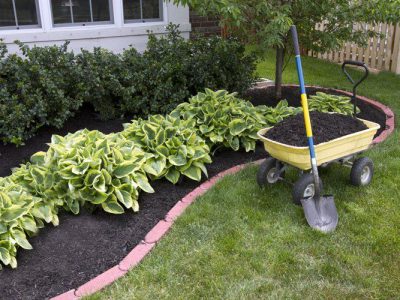The varieties, the depth, the amount….the thought of mulching can provoke dread or motivation. Gardens LOVE mulch as it provides many benefits, but to some gardeners it may appear as a monumental task. Think of it as dressing up your garden beds, offering moisture retention and weed prevention. Doing this mulch work now, will certainly prevent more weeding work later.
There are two types of mulch: inorganic and organic. The advantages of inorganic mulches are they’re more cost efficient as they do not require reapplication nearly as frequently as organic mulches. However, there certainly are disadvantages such as inorganic mulches do not offer up any nutrients to the soil and in some cases actually prevent nutrients from reaching their destination. Some of the most commonly seen inorganic mulches are gravel, river rock, and rubber mulch from ground up tires. While all of these options are acceptable, each one has its handicap. Gravel and river rock shift over time allowing cracks to appear where weeds will take hold and they also absorb and reflect the sun creating an oven in that area. This can make it difficult for plants to thrive. Rubber mulch is mostly used on playgrounds due to its soft, flexible nature. It’s actually very good at suppressing weeds, but the jury is still out on the actual toxicity of the rubber. Also, rubber never really breaks down adding an environmental concern.
Organic mulch is typically thought of foremost as more aesthetically pleasurable. It comes in different colors and textures and it is highly friendly to our environment. Grass clippings are probably the most readily available and inexpensive. No travel is involved, nor the opening of one’s wallet, so it’s an easy mulch. It does break down quickly, but it offers up nutrition for the soil by decomposing and putting water back into the terrain. The key is to never put down more than 2 inches at one time or else the grass will form a mat and prevent oxygen from reaching the soil.
Mini Pine Bark Nuggets are an annual bed’s best friend. This mulch is lightweight making it easy to portage and it contributes a significant amount of nitrogen to the soil as it breaks down, all whilst administering a beautifully, reddish-brown presentation to your flower bed!
Pine needles are another fave. My mother still harvests the Pine needles from under her 60 year old White Pine trees and applies a healthy layer to her acid loving garden each season! She’s cautious though to make certain to keep a 3 inch diameter of space between the mulch and the stem of the plants. This prevents fungus from creeping in and decimating plants at will.
For those of us who adore trees, there are some nice options for mulching around the base. Cypress and Pine are the top two as they slowly break down and since gardeners aren’t planting annually in tree and shrub beds, the Cypress and Pine are a perfect fit. In fact, Pine mulch adds aluminum to the soil which assists in lowering the pH and aiding any acid-loving plants…and for the love of trees, please leave at least a 3 inch diameter ring of space around the trunk of your tree or shrub that remains mulch free. We need trees and the bounty of oxygen they provide us, not a nasty fungus growing at the base of your beautiful specimens!
Gardens love to be mulched at any point in the season. There’s no restrictive time frame for application, which allows for great flexibility. Just remember to not pile on mulch too thickly, keep it at least 3 inches away from any tree or shrub stem and your gardens will love you for it!
By Barrie Anderson

